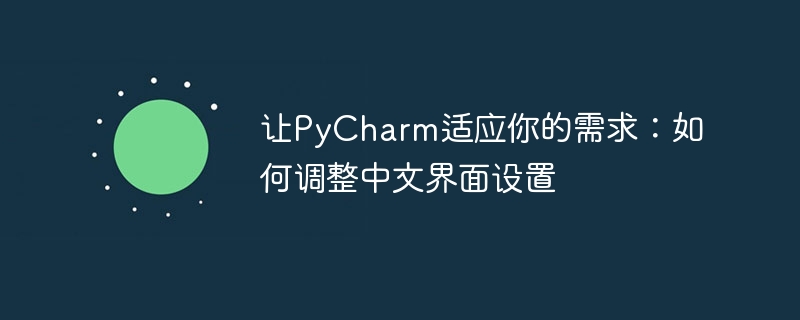Home >Backend Development >Python Tutorial >Adapt PyCharm to your needs: How to adjust Chinese interface settings
Adapt PyCharm to your needs: How to adjust Chinese interface settings
- WBOYOriginal
- 2024-01-27 08:27:161157browse

Let PyCharm adapt to your needs: How to adjust Chinese interface settings, specific code examples are needed
With the widespread application and development of Python, PyCharm has become a popular choice for many Python developers The integrated development environment (IDE) of choice for developers. PyCharm provides a wealth of functions and tools to make development work more efficient and enjoyable. For Chinese developers, a Chinese interface will be more convenient for daily use. This article will introduce how to adjust PyCharm's interface settings to Chinese and provide some specific code examples.
The first step is to install PyCharm. Download the version suitable for your operating system on the official website and follow the prompts to install it. Once the installation is complete, run PyCharm and open your project.
Next, we need to adjust the locale to Chinese. Enter the "File" menu, select the "Settings" option, and then select the "Appearance & Behavior -> Appearance" tab in the pop-up window. In the "Theme" drop-down menu on the right, select the "Darcula" or "IntelliJ" theme (these two themes support Chinese by default). Then, click the "OK" button in the lower right corner of the window to save and apply the settings.
At this point, you will find that the PyCharm interface has been switched to Chinese. However, if you find that the code prompts and error messages are still in English when editing the code, then we need to perform further configuration.
Next, we need to install the Chinese language pack. Click the "File" option on the menu bar, and then select the "Settings" option. Select the "Plugins" tab in the pop-up window, and then click the "Browse Repositories" button in the upper right corner. In the pop-up dialog box, search for the "Chinese" plug-in. After finding the plug-in, click the "Install" button on the right to install it.
After the installation is complete, restart PyCharm. Open the project again and you will find that the code prompts and error messages have changed to Chinese.
Now, let’s look at some specific code examples to help you use PyCharm better.
First, let’s discuss some shortcut keys. In PyCharm, you can use the "Ctrl Z" key combination for undo operations, and the "Ctrl C" and "Ctrl V" key combinations for copy and paste operations. You can also save the file using the "Ctrl S" key combination. These shortcut keys can help you edit code more efficiently.
In addition, PyCharm also provides some code automatic completion functions, which can greatly improve the speed and accuracy of code writing. For example, when you enter a variable name, PyCharm will automatically prompt a drop-down box to list possible options. You can select one or continue typing. In addition, PyCharm will automatically add indents, brackets and other characters for you to make the code format more neat.
In addition to these basic functions, PyCharm also supports many advanced functions and plug-ins, such as code debugging, version control, and code inspection. You can find more details and tutorials about these features on PyCharm’s official website.
To summarize, by adjusting the interface setting of PyCharm to Chinese, we can better adapt to our needs. In this post, we cover how to set up the interface and provide some concrete examples of writing code in PyCharm. I hope this content can help you and make you more comfortable in Python development. Have fun using PyCharm!
The above is the detailed content of Adapt PyCharm to your needs: How to adjust Chinese interface settings. For more information, please follow other related articles on the PHP Chinese website!

